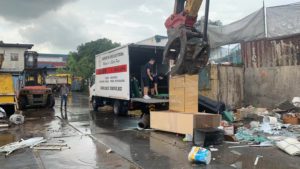
Singapore’s experience in waste sorting-how to dispose furnitures without waste
Discover Singapore’s efficient waste sorting system and learn the right way to dispose of old furniture responsibly
Singapore is famous for its clean and beautiful environment and is known as the “Garden City”. In the “State of the World’s Cities Report” issued by UN-Habitat, Singapore has given high evaluations in the fields of pollution control, traffic management and water treatment. Singapore has a land area of 714.3 square kilometers and a population of 5.64 million (2018 data), with a population density of 7,896 people per square kilometer. Solid waste generation in Singapore has increased significantly over the years, with the amount of waste sent for disposal increasing from 1,260 tonnes per day in 1970 to 8,559 tonnes per day in 2016 (excluding recycled solid waste), based on limited land Areas and densely populated living environments, efficient garbage collection and disposal systems are crucial.
In terms of garbage classification, Singapore aims to be a “zero-waste country”, controls the generation of garbage from the source, and strives to reuse and recycle garbage, giving garbage a second life.

Singapore mainly divides waste into two categories: recyclable waste and non-recyclable waste. Generally, blue trash cans are used for recyclable garbage, and green trash cans are used for non-recyclable garbage. The blue bins are subdivided into 4 categories of recyclable waste, and each is pasted with eye-catching logos: blue for plastic products, green for paper products, red for glass products, and yellow for metal products. Bulky recyclables need to be handled separately.
While advocating the sorting of waste, the Singapore government pays attention to reducing the source of waste, such as reducing excessive packaging, and makes efforts in the harmless treatment and recycling of waste in order not to increase the corresponding burden on residents due to the excessive sorting of waste. The non-recyclable garbage will be sent to the garbage incineration plant for incineration. The volume of the garbage will generally be reduced by 90% after incineration, and then it will be disposed of in a harmless landfill; the remaining recyclable garbage will be transported to the garbage treatment plant by special machines and some manual labor. Sorting, separating the plastic, glass, metal, etc., for sale or secondary processing, and reprocessing the remaining part to make bricks or paving.
At present, Singapore generates about 21,000 tons of garbage every day, of which 60% is recycled and treated and disposed of about 8,600 tons per day. The incineration residues and non-incinerators that are finally transported to the Semakao Island Landfill are less than 1,000 tons. Such high volume reduction efficiency is entirely dependent on an efficient garbage collection and classification system.

(1) Payment mechanism for garbage removal and transportation
The recycling rate of up to 60% of waste in Singapore is closely related to the payment mechanism for waste removal and transportation. Singapore implements a garbage collection and transportation payment system. The pricing of the fee is divided into two methods: fixed fee and regularly assessed fee. A fixed fee is implemented for ordinary residents, which is about SGD 6 per month, and the price is relatively low, and government subsidies can be applied for special groups; The industrial and commercial charges are approved every six months based on the amount of garbage generated, and a tiered charging system is implemented to encourage garbage reduction. Each collection and transportation company entrusts Singapore Energy Co., Ltd. to collect garbage collection and transportation fees from residents, which are collected together with tap water, electricity and other fees, so the payment rate can reach nearly 100%. In addition to the freight charges, this fee also includes the waste disposal fee, which is collected and paid by the consignor and transporter to the transfer center and each incineration plant. The profits of various garbage collectors and transporters mainly come from the recycling of garbage. The first is to maximize the recovery rate to reduce the terminal disposal costs paid to incinerators and transfer stations, and the second is to further decompose and utilize the recycled garbage to obtain the residual value of the waste. Driven by economic interests, each collection and transporter actively adopts advanced technical means and strengthens personnel management to achieve maximum garbage recycling.
(2) Supervision mechanism for collection and transportation
The Singapore government has formulated a series of laws, regulations and quality standards for solid waste treatment, including the Environmental Protection and Management Act, the Environmental Public Health (Toxic Industrial Waste) Management Regulations, and the Environmental Public Health (General Waste Collection) Management Regulations. Wait. These laws and regulations have made detailed descriptions and regulations on garbage collection and treatment in Singapore, which are helpful to realize the standardization, scientific and sustainable development of garbage collection and treatment.
The National Environment Agency of Singapore manages the waste sorting and recycling effect of collectors and transporters through legal supervision and punishment. Illegal dumping of waste is a serious offense in Singapore and faces hefty fines and even penalties. In the garbage collection and transportation process, the behavior of residents and collectors and transporters are managed through illegal dumping penalties to ensure a 100% garbage collection and transportation rate.
(3) Garbage classification and treatment mechanism
The waste sorting and recycling work in Singapore is mainly completed by collectors and transporters. The sorting and packaging are completed at the waste sorting center through semi-automatic and manual sorting lines, and then sent to various waste terminal treatment facilities. Singapore’s solid waste treatment facilities include 1 transfer station, 4 waste incineration plants and 1 marine landfill. The collector and transporter will transport the sorted garbage to the Tuas Ocean Transfer Station and various incineration plants. The garbage must be attached with a waybill, indicating the type and source of production. The staff of each treatment facility will also check the garbage to verify whether the classification is accurate. If the garbage not suitable for incineration is mixed into the incineration garbage category, it will also face penalties.
It can be seen that the classification and recycling of waste in Singapore can be achieved by means of clear responsibility subjects, clear corporate responsibilities, legal supervision and market regulation.
Singapore adopts strict garbage disposal methods, and takes the “3R” (Reduce, Reuse, Recycle) principle, that is, “reduce, reuse, and recycle” as the core, reduce the generation of garbage from the source, and try to reduce the amount of garbage through resource treatment. Garbage is recycled.
(1) Source control of garbage growth (Reduce)
To manage the rapid growth of waste at source, Singapore is doing so by reducing the materials and packaging required to manufacture products. Since 2007, the Singapore government, business community and NGOs have jointly initiated and signed a “Voluntary Packaging Agreement”. Since product packaging waste accounts for about 1/3 of the daily waste in Singapore, the purpose of signing the “Voluntary Packaging Agreement” is to reduce packaging waste by redesigning packaging and recycling. According to the agreement, the companies that signed the agreement, including product manufacturers, retailers, wholesalers, etc., should take the initiative to formulate standards for reducing the number of packaging. According to calculations, as of 2016, thanks to the signing of the agreement, Singapore has reduced a total of 32,000 tons of packaging waste, saving S$75 million in expenses.
(2) Recycling at home and in industry and commerce (Reuse)
Recycling is encouraged for households and businesses, and schools, condominiums and HDB flats also provide comprehensive recycling facilities. At present, in terms of recycling, 97% of industrial iron slag, 99% of construction and demolition waste, 69% of trees and wood, the lowest proportion is plastic, and only 11% is recycled.

(3) Promote garbage recycling (Recycle)
The Singapore government has effectively reduced the amount of landfill by means of resource reuse, incineration and recycling. Only 3% of Singapore’s daily waste that is not recyclable or incinerator goes directly to landfill. The Singapore government clearly stipulates that garbage collectors need to attach a waybill when transporting garbage, indicating the type of garbage and the source of the garbage. The thermal energy generated during the incineration of domestic waste will also be used for power generation, and the ashes and incombustible wastes such as construction waste and industrial residues generated after incineration will first use a magnet separator to absorb the scrap iron contained in them, and then remove the remaining waste. Concentrated at Tuas South Shipping Interchange Station, and then set off in the evening by push tugboats and flat-bottomed boats to the offshore Sema Gao Landfill for landfill. Now the Shima Gao landfill has become a place for leisure and entertainment. In addition to using incineration technology to convert 90% of the burned waste into electricity, the Singapore government also uses concrete recycled materials to recycle 98% of construction waste; it uses the recycling and dismantling of electronic waste to develop a new industry of urban waste treatment; Actively develop clean energy to reduce dependence on traditional energy.
By Move Move Movers